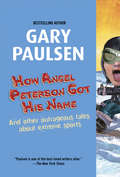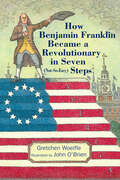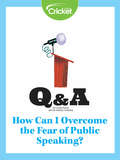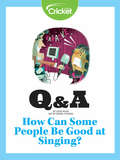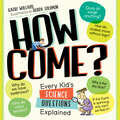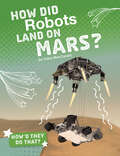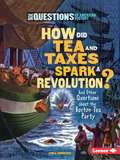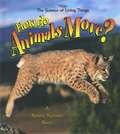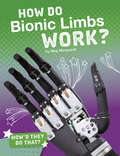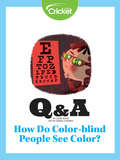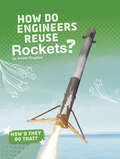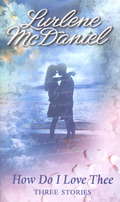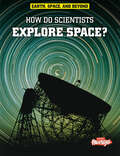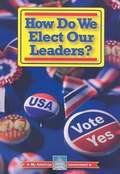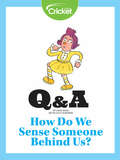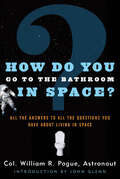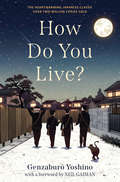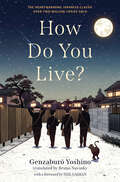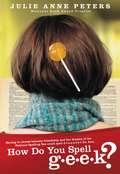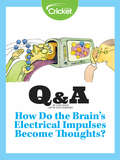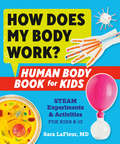- Table View
- List View
How America Works: Understanding Your Government And How You Can Get Involved
by Elliott RebhunLearning about civics shouldn't be boring. How America Works gives teens a fun, behind-the-scenes look at how the U.S. government works, why they should care and how they can get involved. But this isn’t just any old civics primer. Appealing graphics and a conversational tone draw readers in from the very first page. Political cartoons and debates spark critical thought. And age-appropriate explanations make even the most complex civics topics accessible and easy to understand. In short, this comprehensive guide has everything teens need to know about government and civic engagement (and probably don’t).
How Angel Peterson Got His Name: And Other Outrageous Tales about Extreme Sports
by Gary PaulsenGary Paulsen's slapstick tales capture the "wonderful madness" of growing up in a small town in northern Minnesota, when high spirits, showing off for girls, and general idiocy led Gary and his pals to attempt some amazing stunts, including: <P> * Shooting a waterfall in a barrel<P> * Breaking the world speed record on skis <P> * Hang gliding with an army surplus target kite <P> * Inventing the skateboard <P> * Jumping a bike through a hoop of fire <P> * Wrestling with a bear. <P> Wacky, daring, just plain nuts -- extreme sports lead to extreme fun in these stories from Gary's boyhood.
How Benjamin Franklin Became a Revolutionary in Seven (Not-So-Easy) Steps
by Gretchen WoelfleHow did Ben Franklin become an outspoken leader of the American Revolution? Learn all about it in seven (not-so-easy) steps in this humorous, accessible middle-grade chapter book that focuses on Ben&’s political awakening.Famous founding father Benjamin Franklin was a proud subject of the British Empire—until he wasn&’t. It took nearly seventy years and seven not-so-easy steps to turn Benjamin Franklin from a loyal British subject to a British traitor—and a fired-up American revolutionary. In this light, whimsical narrative, young readers learn how Franklin came to be a rebel, beginning with his childhood lesson in street smarts when he buys a whistle at an inflated price. Franklin is a defiant boy who runs away from his apprenticeship, and while he becomes a deep thinker, a brilliant scientist, and a persuasive writer when he grows up, he never loses that spark. As a community leader who tries his best to promote peace and unity both between the colonies and with Great Britain, he becomes more and more convinced that independence for the American colonies is the way forward.Illustrated throughout with art by noted New Yorker cartoonist and illustrator John O&’Brien and sprinkled with quotations from Franklin, this unfamiliar story of a familiar figure in American history will surprise and delight young readers.
How Can I Be a Detective If I Have to Babysit?
by Linda BaileyDetective Stevie Diamond and her partner, Jesse Kulniki, take off for her dad's tree-planting camp in desperate need of adventure. What they find is a job taking care of five-year-old Alexander Creely. It's insulting! Stevie is steaming until she hears about Rubberface Ragnall--a smuggler who has been ransacking Alexander's trailer. Suddenly, baby-sitting seems the perfect job for the Diamond and Kulniki Detective Agency.
How Can I Overcome the Fear of Public Speaking?
by Lizzie WadeSome people are afraid of public speaking more than others. Learn about some surprising ways to overcome stage fright.
How Can Some People Be Good at Singing?
by Lizzie WadeSome people are better at singing than others. Why is that? A researcher explains why some people love doing karaoke, and others simply can't do it.
How Come?: Every Kid's Science Questions Explained
by Kathy WollardFact-filled, fun-filled, as interesting to parents as it is to kids, the How Come? series is the trusted source for lively, clear answers to kids’ science queries. Now the best questions and answers from all three books—How Come?; How Come? Planet Earth; and How Come? In the Neighborhood—have been revised, updated, freshly illustrated in full color, supplemented with twenty completely new questions, and combined into one bigger, better volume. How Come? explains, in fascinating detail, more than 200 mysteries and phenomena in the world around us. These are the questions that pique kids’ curiosity—and stump parents.When it rains, does running (rather than walking) to the nearest shelter really keep you any drier? How can a stone skip across a pond (instead of sink)? If the Earth is spinning, why can’t we feel it? Why don’t we fly off? Why do elephants have trunks? And the all-time classic, Why is the sky blue? (Sunlight has a hidden rainbow of colors, and air molecules scatter blues the most—sending bright blue light down to Earth.) The text is clearly written, engaging, and accessible. It’s for every kid who wants to know—and every grown-up who simply doesn’t know.
How Did Humans Go Extinct?
by Paul Hoppe Johnny MarcianoLet’s learn about the most mystifying species to ever walk the Earth!“A clever . . . way to bring awareness to the very real threats to humanity posed by war, climate change, and capitalism. A compelling and unique dystopian sci-fi picture book for early school age readers, this is recommended for all collections.” —School Library JournalPlib is like every other Nøørfbløøk kid on Earth, except for one thing.He loves humans—those horrible, terrifying monsters who dominated the planet ten million years ago.Only one thing about the humans bothers Plib. What happened to them all? Did they turn the planet into an uninhabitable wasteland? Or did they turn on each other? Or did the humans die out because of something else they did—or didn’t—do?Find the answer in How Did Humans Go Extinct?
How Did Robots Land on Mars? (How'd They Do That? Ser.)
by Clara MacCaraldAfter traveling millions of miles through space, roving robots gently landed on Mars and then drove across its surface. Read this book to learn how engineers accomplished these amazing feats of space exploration.
How Did Tea And Taxes Spark A Revolution?: And Other Questions About The Boston Tea Party (Six Questions Of American History)
by Linda GondoschOn a cold evening in December 1773, a group of men climbed aboard three ships docked in Boston Harbor. Armed with hatchets, the men began breaking into the ships’ valuable cargo―342 crates of tea. They dumped the tea into the black water of the harbor and then marched back home through the city streets. This “Boston Tea Party” was a bold act of protest by American colonists against British rule. It pushed the colonies and Great Britain a step closer to war. But who were these protestors? Why would they risk angering the powerful British government? And how did the British respond? Discover the facts about the Boston Tea Party and the colonists’ struggle for independent rule.
How Do Animals Move?
by Bobbie Kalman Niki WalkerSlithering snakes, jumping kangaroos, flying albatrosses, and swimming salmon--every animal, including humans, has its own unique way of getting around. This beautiful new book explains the how, why, and "are we there yet?" of animals large and small across the globe. Topics include: *how an animal's environment affects its movement *how an animal's skeleton affects its movement *unusual animal movers such as the water-walking basilisk *how a parent helps its young move around
How Do Bionic Limbs Work? (How'd They Do That? Ser.)
by Meg MarquardtPeople who lose limbs now have incredible options to help them walk and do other everyday activities. Read this book to learn how engineers are creating bionic limbs to help patients.
How Do Color-blind People See Color?
by Lizzie WadeTo understand what it means to be color-blind, you must first understand how most of us see color.
How Do Engineers Reuse Rockets? (How'd They Do That? Ser.)
by Arnold RingstadReusable rockets are making space travel cheaper and more common. Read this book to discover how engineers bring huge rockets to a safe, gentle landing.
How Do I Love Thee
by Lurlene McdanielThough written more than a century ago, Elizabeth Barrett Browning's beautiful sonnet rings true today for three young couples who believe in the power of love. <P> In "Night Vision," Brett finds a way to brighten a special girl's lonely existence.<P> "Bobby's Girl" features Dana, who must choose between two brothers, both of whom she loves.<P> "Laura's Heart," the third story, introduces 16-year-old Laura Carson, who is hospitalized on a regular basis because of her weak heart. But when tragedy strikes a loved one, she realizes her heart is stronger than she thought and that love lives on forever.
How Do We Elect Our Leaders? (My American Government)
by William David ThomasIn what ways are the branches of government like a basketball game? How can a school yard game's rules liken themselves to a constitution? Through engaging analogies and introductions, our new government series gets students ready for election 2008. Correlated to the fourth and fifth grade social studies curriculum, My American Government introduces students to how our government works. Students learn about the U.S. Constitution, the branches of government, citizens' basic rights, and how we elect our leaders.
How Do We Sense Someone Behind Us?
by Lizzie WadeHow do humans sense when someone is behind them? This Q & A explains the science of peripheral vision.
How Do You Go to the Bathroom in Space?: All the Answers to All the Questions You Have About Living in Space
by William R. PogueHave you ever wondered what it's really like for an astronaut in outer space? From the exciting moments to the day-to-day details, from the serious to the humorous, you'll find answers to every question you've ever had about living in space!What does it feel like to be weightless? Would a sneeze propel you backward? What happens to your body in space? And, most importantly, how do you go to the bathroom in space?Find out the answers from the astronaut who for more than a decade held the world record for the number of days spent living in space!To take advantage of the renewed interest in space travel, thanks to the success of Packing for Mars, this re-release of the bestseller (with over a quarter million copies in print) features a fresh look, dozens of authentic NASA photographs, and an introduction by John Glenn.At the Publisher's request, this title is being sold without Digital Rights Management Software (DRM) applied.
How Do You Live?
by Genzaburo YoshinoAnime master Hayao Miyazaki's favorite childhood book and a beloved Japanese classic, this uplifting coming-of-age story brings philosophy, history and wonder together, available in English for the first time.The streets of Tokyo swarm below fifteen-year-old Copper as he gazes out into the city of his childhood. Struck by the thought of the infinite people whose lives play out alongside his own, he begins to wonder, how do you live? Considering life's biggest questions for the first time after the death of his father, Copper turns to his dear uncle for heart-warming wisdom. As the old man guides the boy on a journey of philosophical discovery, a timeless tale unfolds, offering a poignant reflection on what it means to be human. But when Copper betrays one of his new friends, how will he ask for forgiveness — and how can he forgive himself? How Do You Live? is the inspiring, transformative story of a young man who, like his namesake Copernicus, looks to the stars and uses his discoveries to answer the question of what kind of person he will grow up to be.
How Do You Live?
by Genzaburo YoshinoThe first English translation of the classic Japanese novel, a childhood favorite of anime master Hayao Miyazaki (Spirited Away, My Neighbor Totoro, Howl’s Moving Castle), with an introduction by Neil Gaiman. <p><p> First published in 1937, Genzaburō Yoshino’s How Do You Live? has long been acknowledged in Japan as a crossover classic for young readers. Academy Award–winning animator Hayao Miyazaki has called it his favorite childhood book and announced plans to emerge from retirement to make it the basis of a final film. <p><p> How Do You Live? is narrated in two voices. The first belongs to Copper, fifteen, who after the death of his father must confront inevitable and enormous change, including his own betrayal of his best friend. In between episodes of Copper’s emerging story, his uncle writes to him in a journal, sharing knowledge and offering advice on life’s big questions as Copper begins to encounter them. Over the course of the story, Copper, like his namesake Copernicus, looks to the stars, and uses his discoveries about the heavens, earth, and human nature to answer the question of how he will live. <p><p> This first-ever English-language translation of a Japanese classic about finding one’s place in a world both infinitely large and unimaginably small is perfect for readers of philosophical fiction like The Alchemist and The Little Prince, as well as Miyazaki fans eager to understand one of his most important influences.
How Do You Spell G-E-E-K?
by Julie Anne PetersBest friends Kimberly and Ann both have a dream to make it to the National Spelling Bee in Washington, D.C. Eighth grade is the last year they can qualify, so they are practicing day and night. But when Ann is assigned to sponsor new student Lurlene Brueggemeyer, who turns out to be an amazing speller, suddenly her relationship with Kimberly and her chances of winning the competition are put to the test. If the three girls end up competing against each other for the prize, that can spell only one thing... t-r-o-u-b-l-e.
How Do the Brain's Electrical Impulses Become Thoughts?
by Lizzie WadeHow do brain impulses translate into a state of mind? This Q & A explores the science of the brain and gives an insight into feelings and abilities.
How Does My Body Work? Human Body Book for Kids: STEAM Experiments and Activities for Kids 8-12
by Sara LaFleurHow does your body work? This fun human anatomy book helps kids 8-12 answer that question through awesome, hands-on STEAM/STEM experiments and activities.Entertaining and interactive, The Human Body Book for Kids shows curious kids how their body systems help them move, breathe, fight infections, and keep them alive!Filled with fascinating information about human anatomy, this exciting science book features: • More than 40 STEAM experiments and activities that help kids learn about their amazing bodies. • Full-color illustrations and photographs that highlight the cells, tissues, organs and body systems as well as explain the steps and outcomes of the experiments. • A doctor author, an MD who works with both children and adults and is an expert on the human body inside and out. • Weird and wonderful facts about the human body: Did you know that you&’re about 1 cm taller in the morning than the evening? That a baby is born with 300 bones but has only 206 by the time they&’re an adult? That some children are born with an extra set of ribs surrounding the lungs called &“gorilla ribs&”? • Learning and fun together: Kids will create models, eat experiments, and show off their STEAM skills to family and friends. Endorsed by the co-founder of Apple&’s Siri, this educational book is a great resource for answering kids&’ questions about how their bodies work.

